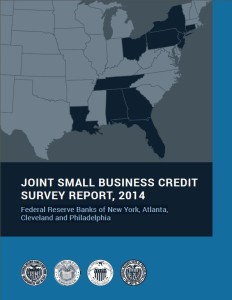 Joint Small Business Credit Survey Report, 2014
Joint Small Business Credit Survey Report, 2014
Federal Reserve Banks of New York, Atlanta, Cleveland and Philadelphia
First published January 2015
Small businesses are important to the U.S. economy and the well-being of local communities. They employ half of the nation’s private sector workers and in recent decades have created two-thirds of net new jobs. Yet, unlike large firms, which rebounded relatively quickly from the Great Recession, the pace of recovery for small firms has been slower and more uneven.
An important part of measuring small business vitality is tracking firms’ demand for and ability to access capital. In the aggregate, there is mounting evidence of improvements in business lending, but small dollar lending only recently began to show signs of modest growth after years of decline. This slow recovery is particularly concerning since microloans ($100 thousand and under) account for 90 percent of small business loans.
Since 2010, the Federal Reserve has been monitoring small business credit conditions through regional surveys of business owners. In 2014, the Federal Reserve Banks of New York, Atlanta, Cleveland, and Philadelphia collaborated on a common small business credit survey to cover much of the eastern region of the U.S. The survey offers insight about the quality and pace of the sector’s recovery by providing evidence on credit conditions from the perspective of borrowers. It is noteworthy in capturing state, industry, and segment level information about firms’ motivations for seeking credit, where they apply for credit, and their success rates.
The survey also highlights the often underdiscussed diversity of small businesses, especially across revenue categories. As illustrated in the key findings and in the detailed report analysis, credit needs, demand, sources, and success vary considerably within the small business sector. Overall, the survey results are intended to provide more precise intelligence to key decision makers, including national and local policymakers, service providers, and lending institutions.
